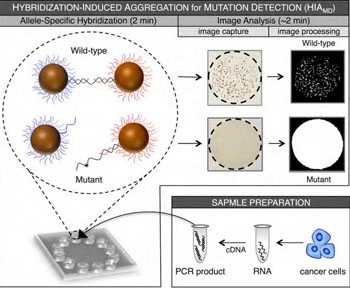Rapid Technique Described for Detection of KRAS Mutations in Pathology Specimens
By LabMedica International staff writers
Posted on 20 Jun 2016
A recent paper described a rapid and inexpensive method for detecting KRAS mutations in clinical biopsy specimens of lung and colorectal cancers.Posted on 20 Jun 2016
KRAS mutations have emerged as powerful predictors of response to targeted therapies in the treatment of lung and colorectal cancers; thus, prospective KRAS genotyping is essential for selecting appropriate treatment. Conventional mutation testing technologies are not ideal for routine clinical screening, as they often involve complex, time-consuming processes and/or costly instrumentation.

Image: Assay principles: Unpurified PCR product is added to a micro well containing probe-conjugated microbeads. A wild-type target hybridizes efficiently to both probes, inducing bead aggregation. Hybridization of a mutant target to the discriminating probe is unfavorable; therefore, the beads remain dispersed. An image of each micro well is obtained and processed to generate a saturation value corresponding to the extent of aggregation (Photo courtesy of The Journal of Molecular Diagnostics).
Investigators at the University of Virginia (Charlottesville, USA) recently described a method that uses hybridization-induced aggregation (HIA) technology for mutation detection (HIAMD), which enables the detection of common KRAS mutations in less than 10 minutes following PCR amplification.
The method is an extension of hybridization-induced aggregation (HIA) technology, whereby the hybridization of a specific DNA target to a pair of oligonucleotide probes immobilized on the surface of microbeads, tethers the microbeads together and induces aggregation. A digital image of the hybridization micro well is used for quantifying the extent of aggregation in terms of image saturation, which allows for a quantitative representation of hybridization efficiency.
The HIAMD method uses samples processed according to current clinical protocols and is compatible with the clinical laboratory workflow for sample preparation, which includes nucleic acid extraction and PCR amplification. After amplification, HIAMD analysis for the detection of all common KRAS mutations (located in codons 12 and 13) is complete in less than10 minutes, which includes approximately three minutes for thermal denaturation and snap-cool, approximately one minute for pipetting the reagents (sample, buffer, and beads) onto the chip, two minutes for the hybridization assay, and approximately three minutes for image analysis. Sequencing analysis, on the other hand, requires further sample preparation, including a tedious PCR cleanup step, and has a turnaround time in the order of days. The simple instrumentation needed for HIAMD keeps the method very low in cost (approximately 2500 USD for all equipment, compared to approximately 100,000 USD for sequencing instrumentation).
The investigators evaluated the clinical utility of the HIAMD method for the analysis of 20 lung and colon tumor pathology specimens. They observed a 100% correlation between the KRAS mutation statuses determined by HIAMD and by classical sequencing. In addition, they were able to detect KRAS mutations in a background of 75% wild-type DNA—a finding consistent with that reported for sequencing.
"These results indicate the validity of HIAMD as a mutation-testing technology suitable for practical clinical testing," said senior author Dr. Kimberly A. Kelly, professor of biomedical engineering at the University of Virginia. "Importantly, the analysis is performed in a manner that is both rapid and cost effective. The current direction of clinical oncology research suggests that a technology such as HIAMD will continue to be a highly relevant and valued analytical tool for the facilitation of individualized therapeutic strategies, and the successes here indicate the potential to apply this technology for the routine analysis of other important genetic markers."
"Targeted therapies are a growing trend in basic and clinical cancer research, and for good reason - the potential for improved treatment outcomes and cost savings is tremendous," said Dr. Kelly. "However, the effective implementation of a targeted therapeutic regime requires a practical means for preemptive molecular characterization of the cancer. In an effort to fulfill the unmet clinical demand for a methodology amenable to the requirements of routine testing, we developed a novel approach that provides simple, rapid, and inexpensive detection of point mutations."
The paper was published in the June 8, 2016, online edition of The Journal of Molecular Diagnostics.
Related Links:
University of Virginia














